The ASUS Zenbook UX305 Review
by Brett Howse on March 25, 2015 8:00 AM ESTGPU Performance
On the GPU side, the Core M-5Y10 has the Intel HD 5300 Gen8 graphics of Broadwell, but with clock speeds of 100 Mhz to 800 Mhz, as compared to the 5Y71 which has 300MHz to 900 MHz available. We have tested several Broadwell processors so far, and the Gen8 graphics are a reasonable boost over the Haswell Gen 7.5 model, with a bump in execution units (EU) from 20 on Haswell to 24 on Broadwell. The Yoga 3 Pro has the Core M 5Y71, which on paper should offer more performance than the 5Y10 based UX305 that we received for review.
One thing that became clear on the Yoga 3 Pro review was how even though the GPU was the same number of EUs as the Broadwell-U processors, and it has the same base and boost clock speed, the 4.5 watt window of Core M limited performance quite a bit. As we saw on the system performance already though, ASUS has elected to allow Core M to get hotter, so that may change the outcome on the GPU as well.
FutureMark 3DMark

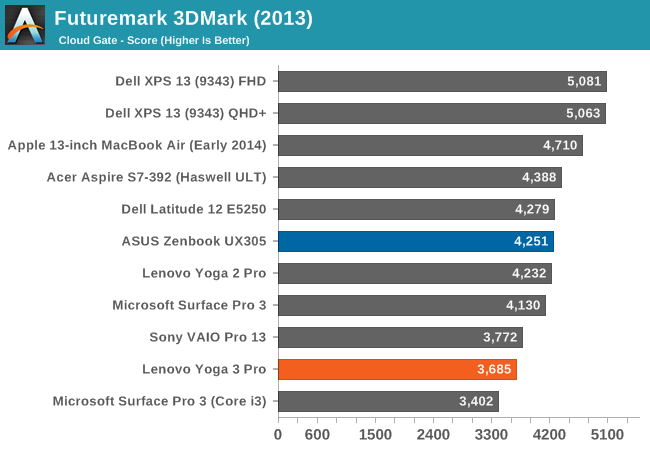
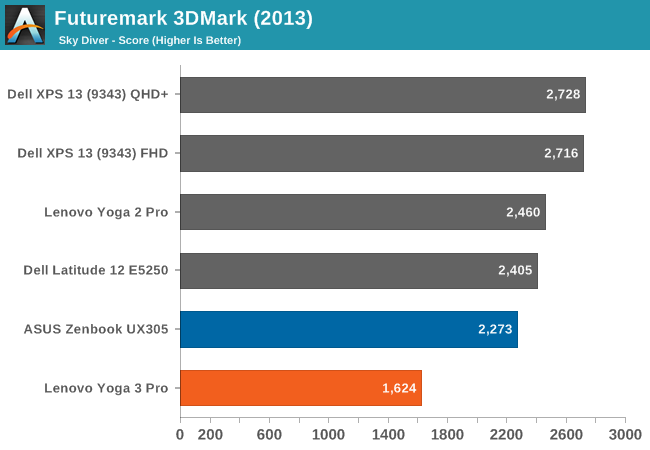

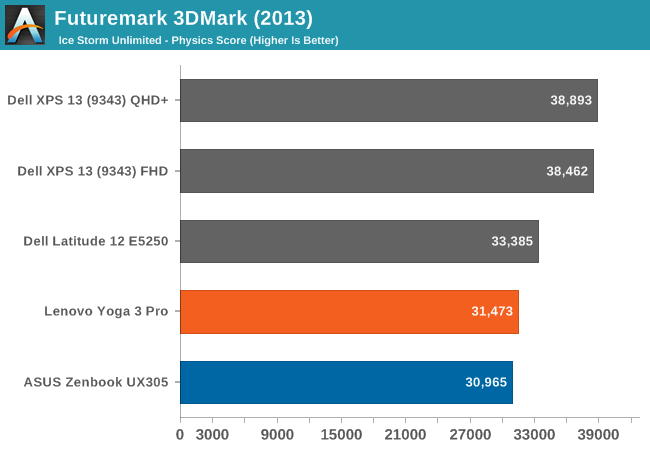
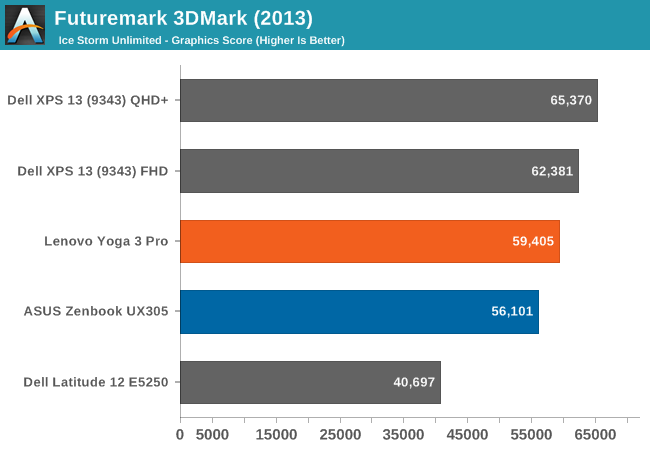
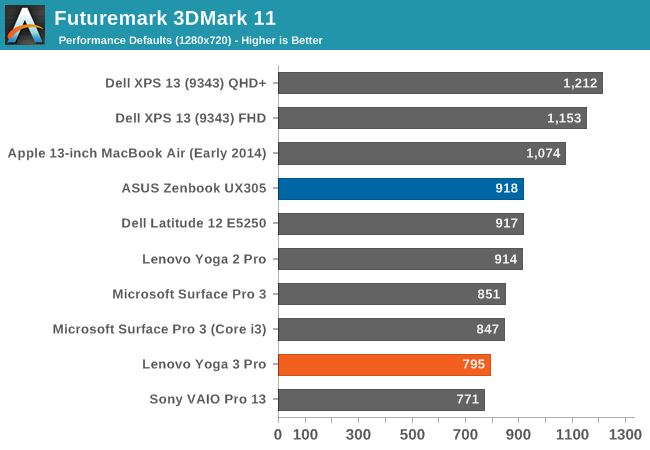
FutureMark has compiled several benchmarks in 3DMark 2013. All are a reasonable length, except for Ice Storm Unlimited which is more of a smartphone/tablet benchmark, and therefore completes very quickly on a PC. Here we can see how much more performance the ASUS UX305 can deliver over the Yoga 3 Pro, which again on paper has a faster processor. ASUS allows much more thermal headroom on the SoC, which results in considerably better scores when using the GPU. The exception to this is the Ice Storm Unlimited, which completes quick enough that the Yoga 3 Pro does not have to throttle as much.
GFXBench
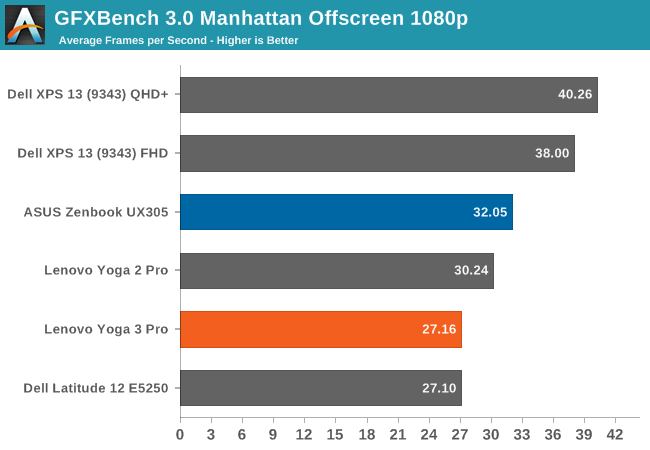
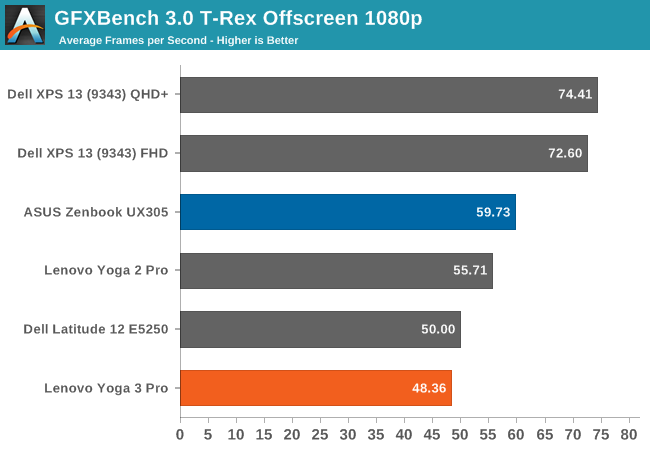
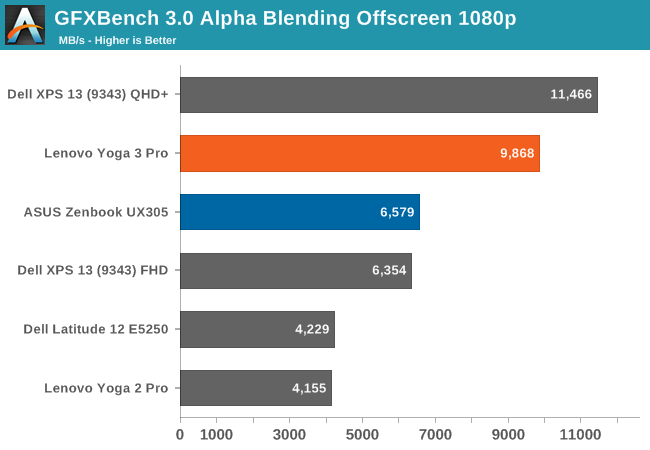
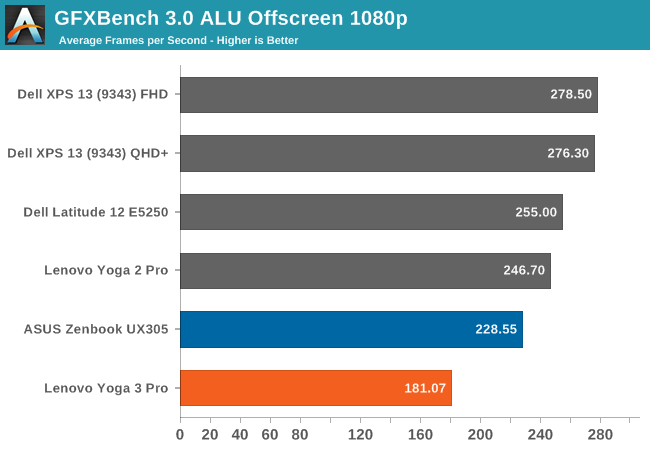
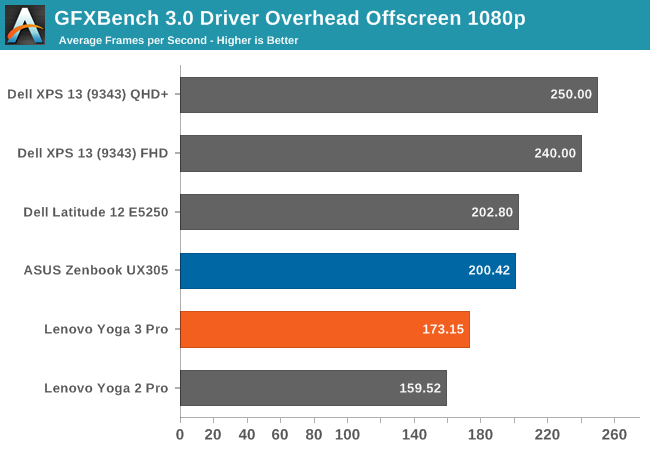
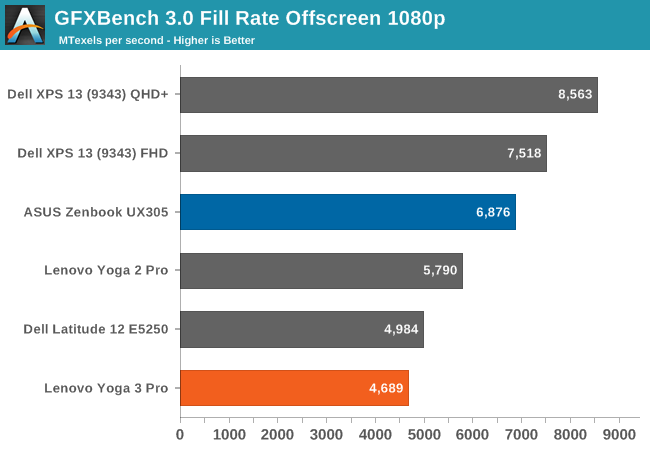
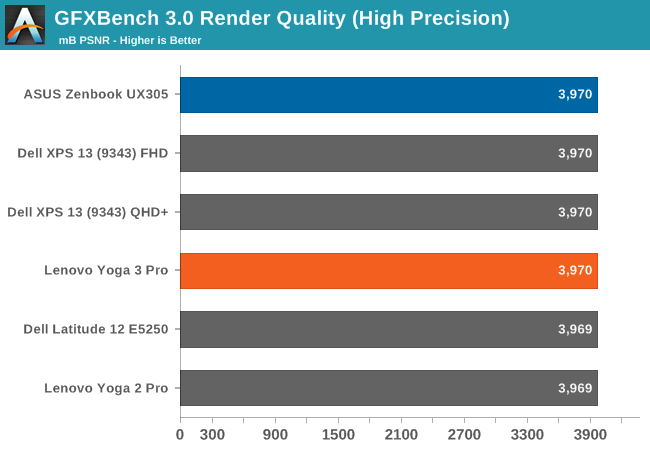
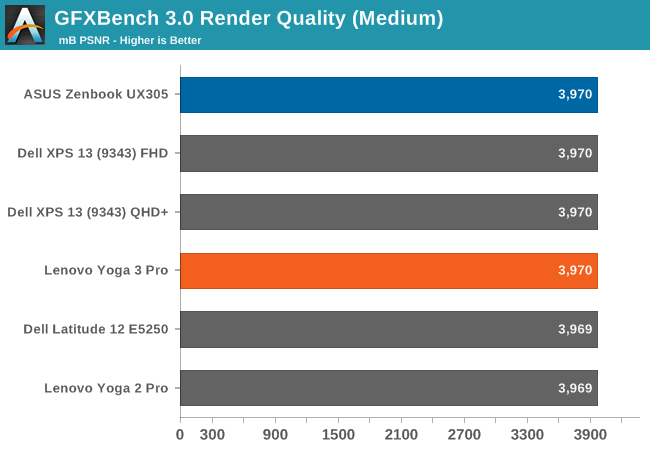
GFXBench 3.0 is available in the Windows Store, and is a DirectX version of GFXBench. On the two gaming benchmarks (Manhattan and T-Rex) we can see that the UX305 pulls ahead of both of the Haswell-U based devices in our graphs, which are the Yoga 2 Pro and the Latitude 12. The Dell XPS 13, with Broadwell-U, is still a lot more powerful which is not surprising since it has a 15 watt TDP compared to just 4.5 watts on Core M (Broadwell-Y). Once again, we can see that the ASUS is stronger than the Yoga 3 Pro.
DOTA 2 Benchmarks
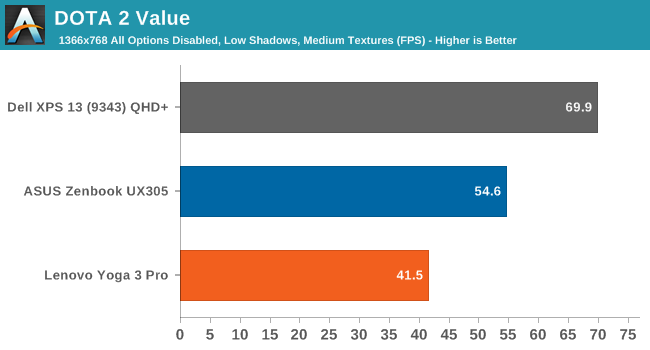
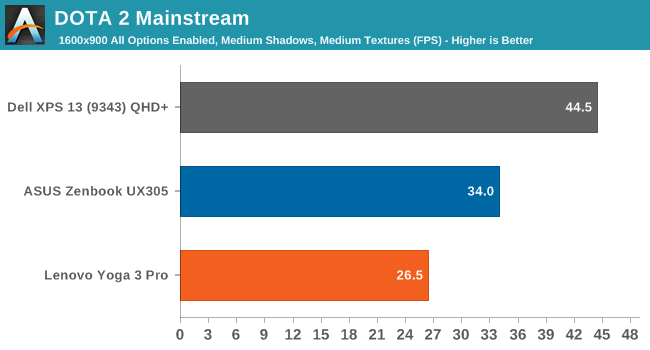
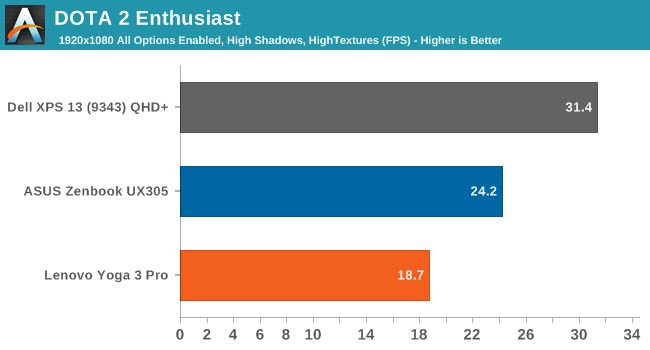
One area where the Yoga 3 Pro struggled was with our DOTA 2 benchmark, which is quite long in duration. We run at three different levels, and the Yoga 3 Pro fell quite far behind the Dell XPS 13. The ASUS UX305 closes that gap though, and gave a much higher frames per second than the Yoga 3 Pro.
Tablet Comparison
As with the Yoga 3 Pro, we will compare the ASUS UX305 to several tablets to see where Core M fits in the lineup. The UX305 is certainly not a tablet competitor unlike the Yoga 3 Pro, but the improved GPU performance seen in the laptop comparisons should give us some more information to about where the Intel graphics compare to the best SoC GPUs available today.
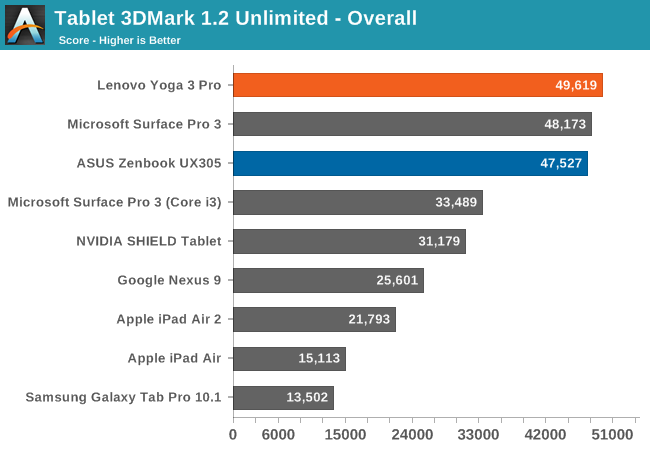
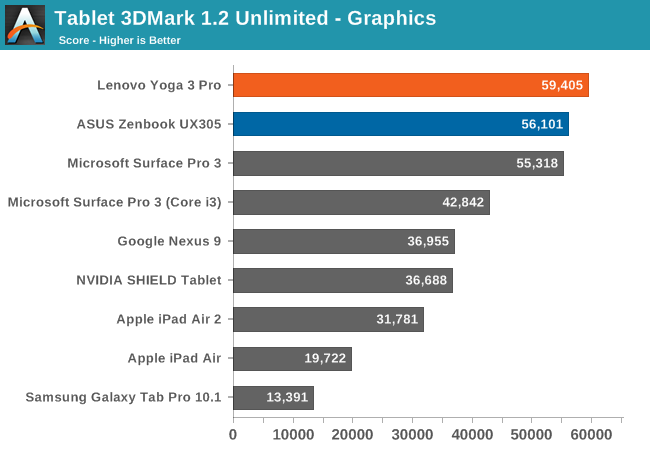

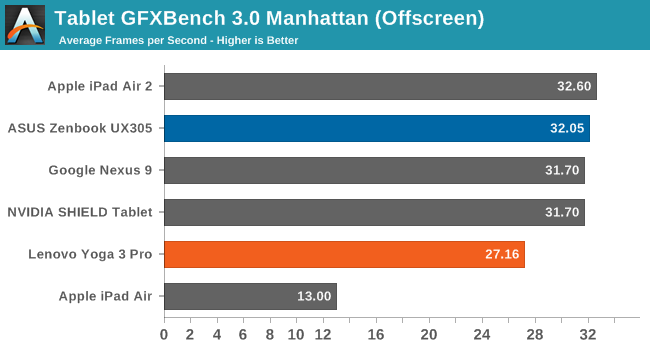
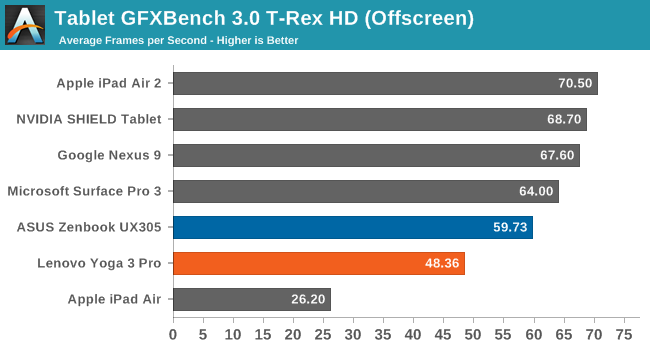


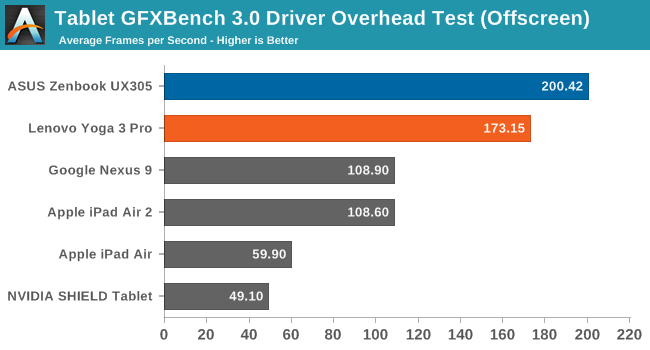
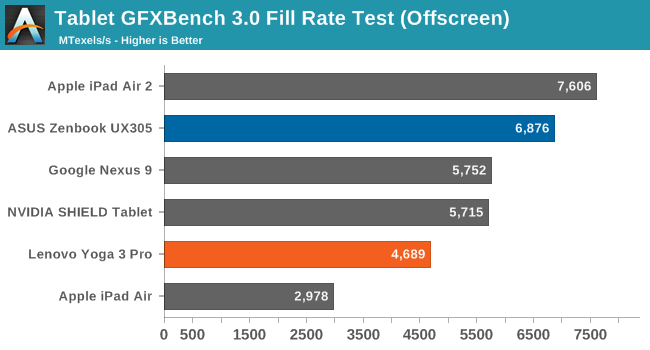
3DMark Unlimited shows the capabilities of the GPU, but is so short that the throttling issues we have observed do not come in to play. The Gen8 graphics of HD 5300 should certainly be able to compete favorably to any of the tablet SoCs if give enough headroom, however that is obviously not the case.
The GFXBench scores show that the Core M 5Y10 can compete with tablets, with it coming in very close to the same scores as all of the latest tablets on the Manhattan score. The T-Rex benchmark is much easier, and it falls behind a bit, but is still a lot quicker than the Yoga 3 Pro.
GPU Conclusion
The increased thermal headroom that ASUS allows on the UX305 has dramatically increased the GPU performance of Core M when compared to the Yoga 3 Pro. The device does get warm though, with it hitting close to 50°C at the top of the laptop, but it does not affect the keyboard or wrist areas. The lack of a fan makes these scores even more surprising, but Lenovo has opted to keep the surface temperatures a lot lower on the Yoga 3 Pro.
There is a lot to be said about Core M performance, and too much to put in this review. We will be doing a deeper dive into the performance of Core M and how it performs in various devices, both actively and passively cooled, as well as compared to Broadwell-U based systems which are a more traditional design. Clearly, there is a lot of factors that affect performance in a device such as this than just the label on the spec sheet.


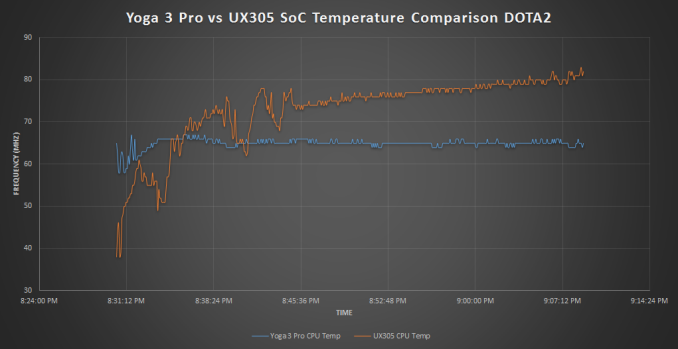








164 Comments
View All Comments
Klug4Pres - Wednesday, March 25, 2015 - link
Fair enough. I suppose I feel like we used to have a sane product line up for laptops, where 3 or 4 lbs was as light as anyone needed, then you had 5-6 lb machines that were workhorses with good expandability and possibly better value if you didn't need to shed all the weight, and then desktop replacements that could be as heavy as they needed to be.Now everything seems to be getting absurdly slim for no obvious reason, while maintainability and expandability are dirty words.
kingpotnoodle - Thursday, March 26, 2015 - link
Most people consider 3-4lbs a weight to drag about, add into that a charger brick and the the chunky bag and you're quite weighed down. Contrast that to a laptop like this which has an all-day battery life (or much smalller charger) and slips into a thin sleeve case, sure you have to make sacrifices but it's all about priorities. There are plenty of fat, more upgradeable laptops around as well in all shapes and sizes. Once size doesn't fit all, never has.Dorek - Thursday, March 26, 2015 - link
Anyone who considers 3 pounds "a weight to drag about" must be from a planet where gravity is lower. 3 pounds is NOT HEAVY.bznotins - Wednesday, March 25, 2015 - link
Try lugging a 5lb laptop + brick + accessories across a dozen airports over the course of a month and you'll appreciate every ounce of weight savings you can muster.Try opening a 14" laptop on a plane in coach when the person in their seat reclines. You'll appreciate <13" then.
But if you're the DTR type, then yeah, Intel hasn't been focusing on you. But there are options out there from Clevo and Maingear, among others.
V900 - Wednesday, March 25, 2015 - link
I can understand people want a lighter machine, but you have a point about it going too far, and become a ridiculous race to be half an ounce lighter than the competitor.Once they got under 4 pounds it really ceases to have a point, and they could have invested the weight difference towards either performance or longer battery life. It's not like you can even tell the difference between a 2 pound laptop and a 3 pound laptop, especially once it's inside a bag. If carrying half a pound or a whole pound of additional weight really means that much, and makes that much difference, toss out that half liter bottle of water you probably got in your bag. BOOM! A whole pound of weight saved! Is the bag really that much lighter to carry now? Nah, thought not.
FlushedBubblyJock - Wednesday, March 25, 2015 - link
You forgot to factor in the self-centered elitist narcissism that applauds loudly inside their heads every time they haul out their precious and hope others notice.Thus a tenth of an ounce and one shiny polish point is a king's ransom.
kevith - Wednesday, March 25, 2015 - link
Lol! :-)kmmatney - Wednesday, March 25, 2015 - link
I've been carrying around a heavy 17" laptop for the last 8 years (2 different laptops). I would love to have a lighter laptop, but don't want to give up the 17" screen. I'm a heavy traveler, approaching 1 million miles on United, but my laptop case has wheels and it's not that big a deal to lug around. I wish they still made 17" laptops with 1200p screens.Duncan Macdonald - Wednesday, March 25, 2015 - link
As you did the calibration for your test machine - would it be possible for you to provide an ICC profile ? (This would also be useful for other devices with poor initial calibrations that you test.)djvita - Wednesday, March 25, 2015 - link
anandtech should post the RGB levels/ profile they used to calibrate, for goodwill of buyers =)